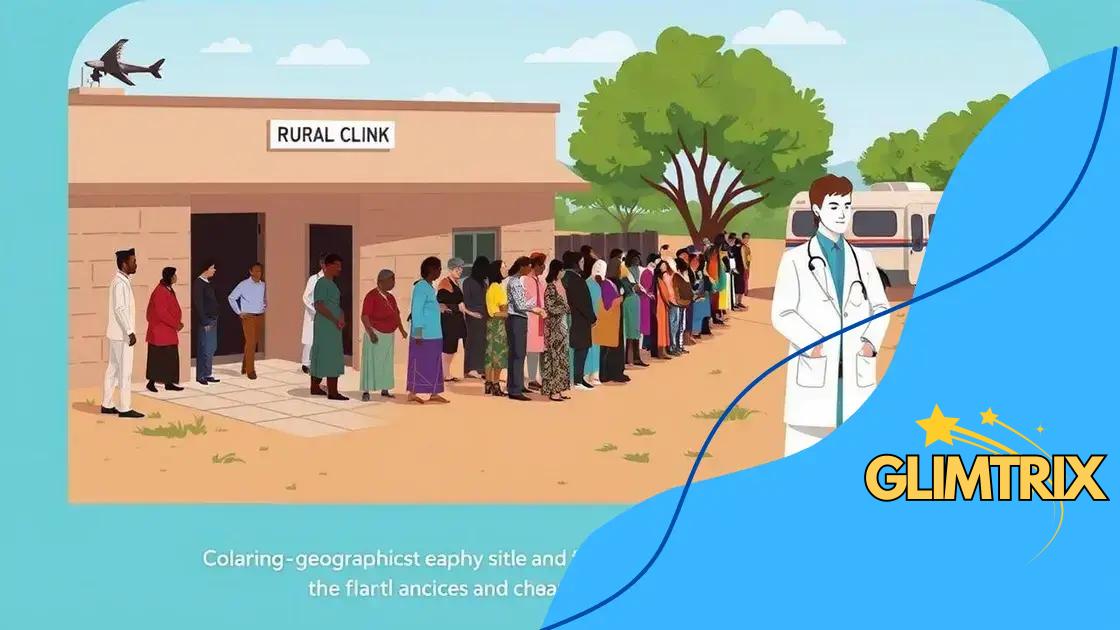Expansion of Medicaid benefits in rural areas: a necessary change

The expansion of Medicaid benefits in rural areas significantly improves healthcare access, reduces uninsured rates, and enhances overall community health through innovative solutions and increased funding for local health initiatives.
Expansion of Medicaid benefits in rural areas is a topic that resonates with many, especially those facing health challenges far from urban centers. Have you considered how these changes could touch lives in your community?
Understanding Medicaid benefits
Understanding Medicaid benefits is crucial for low-income individuals and families, especially in rural areas. Many people may not fully grasp how these benefits can improve their healthcare access and overall well-being.
What Are Medicaid Benefits?
Medicaid is a government program that helps cover medical costs for eligible individuals. It plays a vital role in providing necessary healthcare services, including hospital visits, preventive care, and long-term care.
Key Features of Medicaid Benefits
- Coverage for a wide range of services
- No or low-cost premiums for eligible individuals
- Access to prescription medications
- Support for mental health services
Many rural residents rely on these benefits, which extend far beyond basic healthcare. With Medicaid, individuals gain access to specialists and treatments that they may find difficult to reach otherwise.
Moreover, understanding these benefits can empower families to seek the care they need without the burden of financial strain. It’s important to know that eligibility varies by state, so researching local options is key.
How to Apply for Medicaid
The application process can seem daunting, but it’s essential for those who qualify. Generally, you can apply online, through phone assistance, or in-person at designated agencies. When applying, be prepared to provide documentation concerning income, residency, and household size.
Once approved, beneficiaries can start receiving care immediately, which is especially important in areas where healthcare access is limited. Regular check-ups and preventive services can lead to better health outcomes.
Why Understanding Medicaid Benefits Matters
Knowledge is power, especially in navigating healthcare options. Understanding Medicaid benefits not only helps individuals make informed decisions but also encourages them to utilize available resources and services.
The impact of rural healthcare access
The impact of rural healthcare access can be profound for communities. Limited healthcare services affect the health outcomes of individuals living in these areas.
Challenges in Rural Healthcare
Access often depends on various factors, such as geography, availability of providers, and transportation. In many rural regions, hospitals are few and far between. This can lead to significant delays in receiving care.
Common Issues Faced
- Long travel distances to the nearest healthcare facility
- Shortage of healthcare professionals
- Lack of emergency services and specialized care
- High costs associated with transportation
These challenges can lead to serious health implications. For instance, individuals may avoid seeking treatment due to the inconvenience of traveling long distances. This can result in conditions worsening over time. Understanding the importance of rural healthcare access encourages communities to advocate for better services.
Despite these obstacles, innovative approaches are being explored. Telehealth is one potential solution, allowing patients to consult with providers from home. This option reduces travel barriers and can increase access to specialists who might not be available locally.
The Importance of Community Health Initiatives
Many rural communities have begun to implement health initiatives aimed at improving access. These initiatives focus on preventative care, education, and wellness programs. By prioritizing health, communities can foster better outcomes.
Ultimately, the impact of rural healthcare access extends beyond individual patients. It influences the entire community’s health and wellbeing, highlighting the need for comprehensive solutions that address these urgent challenges.
Challenges faced in rural areas

Challenges faced in rural areas can significantly affect the community’s overall health and wellbeing. Residents often encounter unique obstacles in accessing adequate healthcare services.
Geographical Barriers
One of the main challenges is geography. Many rural areas are remote, making it difficult for residents to reach healthcare facilities. This can lead to long travel times and increased costs associated with transportation.
Provider Shortages
Healthcare provider shortages are also a common issue. Rural communities often struggle to attract and retain doctors, nurses, and specialists. This shortage means that patients may have to wait longer for appointments or travel great distances to see a doctor.
- Limited access to specialists
- Fewer healthcare options
- Long wait times for appointments
The lack of providers can result in poorer health outcomes, as patients may delay seeking care or miss out on preventative treatments. Additionally, this can put immense pressure on the few healthcare professionals available, leading to burnout.
Financial Barriers
Financial challenges also play a role in rural healthcare access. Many residents may be uninsured or underinsured, making them hesitant to seek medical help due to high out-of-pocket costs. This situation can lead to delayed care or non-compliance with recommended treatments.
Medicaid expansion aims to alleviate some of these financial barriers. By expanding benefits, more residents can have access to necessary services without facing crippling debt.
Transportation Issues
Transportation remains a critical challenge as well. For many rural residents, public transport options are limited or non-existent. This lack of reliable transportation can prevent individuals from attending medical appointments, which is crucial for maintaining health.
Understanding the challenges faced in rural areas is vital for addressing the healthcare disparities that exist. By recognizing these obstacles, communities and policymakers can work towards solutions that enhance healthcare access and improve outcomes for all residents.
Success stories from Medicaid expansion
Success stories from Medicaid expansion highlight the positive changes communities can experience when more residents gain access to essential healthcare services. Many regions have seen substantial improvements in health outcomes as a result.
Improved Access to Healthcare
One major benefit of Medicaid expansion is increased access to healthcare for low-income individuals. In states that have adopted expansion, more people can get needed medical care without the fear of overwhelming costs. Such accessibility allows for preventative care, which is crucial in stopping diseases before they become severe.
Health Improvements
Numerous studies have documented improvements in health metrics. For instance, states that expanded Medicaid have reported:
- Lower rates of uninsured individuals
- Improved management of chronic conditions
- Increased rates of cancer screenings
- Better access to mental health services
These health improvements contribute to a healthier population overall. As individuals gain access to necessary care, they often experience better quality of life and increased productivity. Additionally, these health advancements can significantly benefit the state’s economy.
Community Initiatives and Funding
Medicaid expansion also allows for more funding in local health initiatives. Communities can harness these funds to enhance health education programs and preventive care services, helping everyone, not just those enrolled in Medicaid. By focusing on well-being, rural areas can address significant health disparities.
In some regions, community health centers have reported being able to expand their services, thanks to the influx of Medicaid funding. These centers can provide dental care, mental health services, and wellness check-ups to a broader audience, fostering a healthier environment.
Personal Success Stories
Personal success stories exemplify how Medicaid expansion can transform lives. For example, a middle-aged man living in a rural area who once avoided going to the doctor due to costs found the help he needed after his state expanded Medicaid. With access to regular healthcare, he successfully managed his diabetes, improving his health and work performance.
Such compelling stories shine a light on the practical benefits of Medicaid expansion. They show that with the right access to healthcare resources, individuals can thrive, contributing positively to their communities.
Future of Medicaid in rural communities
The future of Medicaid in rural communities looks promising, especially as more states consider expanding their programs. This expansion can lead to greater healthcare access and improved health outcomes for residents.
Potential for Growth
As awareness of the benefits of expanded Medicaid grows, more rural areas are taking steps to enhance their healthcare systems. Funding from Medicaid can help support local clinics and increase the number of healthcare providers willing to work in these underserved regions.
Innovation in Healthcare Delivery
The future may also see innovations in healthcare delivery through programs like telehealth. Telehealth services allow patients to consult with healthcare providers remotely, reducing the need for travel and enabling access to specialists.
- Improved mental health services via online consultations
- Access to specialists who are not locally available
- Convenient follow-up visits from home
This shift will make it easier for rural residents to receive the care they need without the barriers caused by distance. Enhanced access to technology will play a crucial role in making these improvements happen.
Community Involvement
Community involvement is vital for the ongoing success of Medicaid initiatives. Local organizations can help educate residents about available services and encourage enrollment in Medicaid programs. This grassroots approach fosters a supportive environment that champions healthcare access for everyone.
Furthermore, as healthcare needs evolve, Medicaid can adapt its programs to meet these changing demands. For instance, addressing the rise in mental health challenges and substance abuse issues is essential in promoting overall community health.
Policy Changes and Advocacy
Policy changes at the state and federal levels are crucial in shaping the future of Medicaid. Advocacy efforts can lead to more robust Medicaid programs, ensuring that rural populations receive the care they deserve. By actively pushing for positive change, communities can help secure a sustainable healthcare future.
As states explore strategies to uplift rural health, the focus will remain on lifting barriers to access and providing high-quality care through Medicaid. By working together, communities, providers, and policymakers can shape a brighter future for healthcare in rural areas.
FAQ – Frequently Asked Questions about Medicaid Expansion in Rural Communities
What is Medicaid expansion?
Medicaid expansion allows more low-income individuals to gain access to health insurance, improving healthcare access in underserved areas.
How does Medicaid expansion benefit rural communities?
It increases access to essential health services, reduces the number of uninsured individuals, and supports local healthcare providers.
What role does telehealth play in rural healthcare?
Telehealth facilitates remote consultations, making it easier for rural residents to access specialists and receive ongoing care without traveling long distances.
How can community involvement improve healthcare access?
Community organizations can help educate residents about available services and encourage enrollment in Medicaid programs, fostering a supportive environment.





